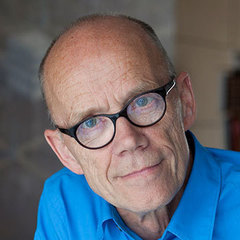Discover legacy content from FontShop.com, preserved for your reference.
A year and a half ago Hannes von Döhren visited the typographic workshop p98a to consult Erik Spiekermann about some historic examples of bold condensed geometric sans serifs. I was part of the conversation back then and chose to meet at this place again – right in time for the release of FF Mark Condensed.

In order to attune ourselves to the topic, a case of Erbar® Grotesk bold condensed in 84 pt is on display. A typeface on which the bold condensed lettering on Berlin’s street signs is based on as well: One quite close to Erbar, while the other was redesigned some years ago …

[link not found]
Erik Spiekermann | … with an ‘a’ that looks like Frutiger®.
Andreas Frohloff | Exactly! I drew that face, as well as the condensed alternative.
ES | That was you? I always wondered. That’s why it turned out so well – before that it looked rather quirky. I asked myself just recently, since there are two versions: The old Erbar one with a belly on the ‘a’ as well as the new one with a straight stroke ending – a beautiful typeface. It looks like a mix of Frutiger and Erbar: The good characteristics of Frutiger with those of Erbar. Obviously, a layman could not have produced it.
Hannes von Döhren | What about the typeface, is it available?
AF | It’s only available at the firm Pötter for whom I designed the typeface.
HvD | So you can’t acquire it anywhere?
ES | That means, it must be available digitally. I was sure that these morons at the authorities could not possibly have done this …
AF | Unfortunately, they wouldn’t let me add a foot to the ‘t’. Initially I did that …
ES | Would be much better actually!
AF | … but then the construction worker of the civil engineering unit, who was supposed to install the sign, said: “That ain’t no real ‘t’ – nah, no way I’m installing that” and Mr. Pötter, who sells the signs, decided: “We’re going to have to change it.”
ES | That’s Germany. The civil engineers make such decisions.
; right the new typeface by Andreas Frohloff.](https://lg-assets.myfonts.com/fs/uploads/content_image/attachment/313243/mini_magick20160316-26111-u7qeiq.jpg)
How come those infamous ligatures – such as ‘tz’ with the descender-‘z’ in “Platz” – are sometimes included and sometimes not? And why do we see more street names set in DIN Condensed lately?
AF | That is because of the people who set the signs. Usually the civil engineering authorities are responsible for street signs. Whenever someone manages to come to an agreement with the head of the authorities: “Come on, I’ll make those signs for ya,” it will be executed to make it work halfway. The firm Pötter in Berlin-Neukölln used to or still makes street signs with this exclusive typeface. However, there are always a few odd mixes that get smuggled through, which are in fact illegal.
I am a big fan of the bold condensed Erbar Grotesk, I really get a lot out of its forms. Nevertheless, here’s a heretical question: Why does a geometric sans serif need a condensed variation? The actual concept of such a face is based on the idea of a circular ‘O’, which often turns into an egg in the condensed version. How do you avoid the egg shape and what exactly makes an FF Mark?
AF | By heavily negotiating a basket arch with Hannes.
HvD | I tend to say: Too much pressure in the curves! When a curve has too much pressure, it usually turns square – that’s Andreas’ basket arch.
AF | The basket arch is rooted in typefaces classified as ‘modern’ and in neoclassic architecture.
HvD | I always have a flowerpot in mind. Or what do you mean by “basket”? Ah, with an arch on top …
AF | … to grab on, to carry it around. Actually, the hilt on a basket and this oblate curve makes it appear less pointed. You have to try to find a compromise.

Christoph Koeberlin | The normal FF Mark is in fact much more geometric than many other typefaces. Since the ‘O’ is so circular and FF Mark overall has so many distinctions, one of the great challenges was: How do you design a condensed Mark that still looks like “FF Mark”? Much of what makes FF Mark cannot simply be pressed into such a condensed shape. Therefore, one of the great struggles was: What will the basic shape look like? Early on I was actually aiming at the egg shape because I thought it had to be consistently geometric. Then there was Erik’s suggestion to try a superellipse shape and another thing in-between, to mediate between these two elements.
HvD | In the beginning, we also had the idea to create an ‘O’ with straights in the middle.
ES | This would have had two points in the middle …
CK | … but we wanted to avoid such a structure.
ES | Just recently Ralph du Carrois and I created a typeface for Autodesk which was also supposed to be a bit geometric, a bit hard. Just like in the Apple OS font San Francisco, there are two points far apart from each other in the ‘O’ in the smaller sizes. In all of the other round shapes and in all of the sizes the two points are still implemented – honestly, I mentioned that more as a sales argument, “there’s a bit discipline in there” and so on – and in FF Mark Condensed there is no such thing. In the meantime, I became quite convinced, although I was not too sure about it in the beginning.
AF | We really debated this, observed it and then decided not to translate pure theory by following the geometric principle as much as possible, but to make sure that a typeface with the appearance of FF Mark resulted from this process.
Jens Kutílek | When we experimented with the straight sections at the sides it quickly began to look like FF DIN® Condensed.
AF | This made its way into the thinking process indeed, but we ruled against those straight sides.

How should one imagine the design process? Was the normal FF Mark made narrow automatically on a computer and corrected later on, or was everything drawn from scratch?
CK | From the beginning on we did not only have the condensed weight in mind, but also a whole series of steps. Actually, the initial approach was to draw an even more condensed weight, a so-called compressed. We quickly learned that the narrower it gets, the more compromises we need to make. So starting from a compressed, we generated an interpolation draft of a condensed, which was then reworked and now appears redrawn. Eventually, there will be a version between the current condensed and the normal weight.

Which is generally known as narrow. What name are you going to give this weight?
CK | There are a few preposterous names out there …
HvD | But what should the name of the width between condensed and normal typically be?
CK | Actually semi condensed …
ES | … in Helvetica® and Arial® it is known as narrow. In German the word for condensed is schmal; compressed is called eng. In the German-speaking countries compressed is narrower than condensed, however compressed sounds rather negative. I tend to use narrow below that.
AF | We currently have a tendency to use narrow, since it is the most widely used term and therefore, the most comprehensible.
CK | The working title so far is based on an abbreviation by Andreas: NaFoTe, “Narrow For Text.”
HvD | I proposed FF Mark Text, but that is indeed a bit misleading, as one might think it is only to be used in smaller sizes. Narrow is currently the front runner.
CK | Back to the original question: Early on we wanted to go the limit of what was possible with the compressed weight and then see if it was at all possible to produce three steps. In made the most sense to work on a condensed as a companion to the normal weight. In the process, we noticed that the narrow weight could possibly be a good alternative to FF Mark. So we decided: Partner first, potential alternatives later.

On FontShop.com FF Mark is credited to Hannes von Döhren, Christoph Koeberlin and the FontFont Type Department. Who did what exactly, and how should one imagine the role allocation in such a large team?
AF | I made FF Mark possible. [laughs] First of all, this was about establishing a collaboration defining our role and that of the external designer – that was a difficult process. My part turned into that of the moderator while the direct collaboration between Christoph and Hannes consisted of the definition of shapes. The hard part was to decide what was valid and where we had to make compromises.
Bernd Vollmer | I contributed the italics to the design of FF Mark Condensed.
AF | We made a provisional preliminary decision – agreeing on angles and different parameters – but Bernd actually did the work.
BV | Once the design for the uprights and the italics was set, I took over the data and handled the steps that are typically unpopular among designers: Font finishing, hinting and production.
ES | Why did we decide to leave out the pointing peak on the ‘M’ in the end?
AF | Because it’s consistent. During the entire process, we created tension between variance and consistency and therefore, we tried, whenever possible …
HvD | “Variance meets consistency” – there’s our title for this article. [laughs]

ES | The ‘R’ is good. Early on we had a great debate: Should it have a drive, should it have a leg – an ‘R’ should look like this, marvelous. It has a fairly large head, which I like. Proportionally it has a larger head than this one [compares FF Mark to Erbar] It has the same height as the head of the ‘R’ in the normal weight, but it seems to be bigger.
AF | Some of the decisions were made by a majority of votes cast. We did want to keep a few things square, which didn’t necessarily meet everyone’s taste.
HvD | A lot of these things are a matter of taste. You might say you don’t like the ‘M’, while someone else might decide: “Wow, the ‘M’ is my favorite letter!”
ES | I totally agree. For example, in my own FF Real® I included an ‘M’ with sloped sides as well as one with straight sides. The Head weights feature the straight ‘M’ to allow setting with tight tracking, but in the Text weights the angled ‘M’ is easier to handle of course. There you can include the middle. Or you solve the problem like Gill did in his Gill Sans™: Stop the vertex in the upper half and end on a pointed peak. The ‘M’ in Futura® on the other hand is overly wide. Even back in the days, I wondered about this, since usually an ‘M’ and a ‘W’ are not too far apart – however, our ‘M’ is much narrower than ‘W’, because it is angled. Then again it has a special touch. You can’t turn the ‘M’ upside-down and make it into ‘W’.
[At that point the conversation dives into minute typographic details that grant interesting insights and are therefore included in this copy – editor’s note.]
ES | There is no double-story ‘g’, right? That would be my favorite letter, even though it doesn’t even fit into this typeface historically. It’s also called “spectacle-g”.
Ivo Gabrowitsch | Are you talking about the ‘a-o’-ligature here? [laughs and shows an FF Real ‘g’ turned on its side]
AF | We had a debate on this.
HvD | I even drew a few, but then we discarded them.
ES | They are hell, yes. I was only joking, but that glyph is a lot of fun. If you can design that, then you can design everything else.

IG | Just to get back to your earlier question about role allocations: I restrained myself from designing, with the exception of details. As such the alternates ‘7’ and ‘Z’ with horizontal strokes were my idea. I acted primarily as a consultant in this project and participated in the debates about how many weights, which widths, which language extensions should be implemented, and I supported these discussions with numbers accordingly. I was also heavily involved in the naming of the typeface.

HvD | That was a long process. I believe in the end we had an A4 page with 50 names or so. “Roland” was in second place. Actually, we weren’t all for Mark in the beginning. It turned out to be the best name one could ever think of.
Jens Kutílek | My task was mainly to use my vote in the internal meetings. Andreas was all for votes, so I could use mine to tip the scales at times.
AF | I think it is good to decide by majority vote because you get the impression that this is a situation to face. Ultimately the problem is: everyone had their favorites, which sometimes made it hard to agree. When you then hold a vote, you know it’s a fact. Personally, you can stand back a little and might have a chance to have your thoughts weigh in the next round. It is a much more compelling process than fighting for something until someone gives way: “Alright, we’ll pick yours then.”
HvD | I do have to say this was interesting. Often times it was a democratic process. No one said, “we’ll do it this way”, it was not like that, but whenever debates came up we had a vote and the majority won.
IG | We sometimes were even able to persuade Hannes.
HvD | Yes, seriously. I wasn’t always 100% in favor of something, but I did concede whenever Andreas was able to convince me. For example, the ‘M’ in FF Mark stops barely above the baseline. At first, I thought this was horrible – Andreas drew that shape – but now I think it’s great. It became a prominent character by which you’ll always recognize the typeface. No other typeface has it.

IG | Same goes for the ‘K’ with the horizontal connecting stroke, we also debated about that for a while. It remains to be one of the best decisions. I feel the same about the ‘t’.
AF | I’d like to point out once more: After we got it together, it was clear that we are a competent committee and that everyone accepts everybody else. This way we were able to hold majority votes, because we had a democratic basis. Everyone had the same right and the same chance to assert themselves.
JK | This was not about outvoting somebody else, because all in all we were on the same line, so sometimes there were decisions that could have gone in either this or that direction …
AF | Whenever you need a decision, a majority is great. I liked this process a lot.
IG | I think everyone learned something from this. In fact, I would go so far as to say this was a nearly perfect process.

Is there any detail in the font that you feel is not yet full-fledged, with room for improvement just in time before the release?
ES | What I am noticing: The ‘s’ is beautiful, but it is rather wide for this typeface when you look at the copy here. It is as wide as the ‘o’.
HvD | It was part of the concept to make all letters similarly wide.
ES | But have a look at these [points at Erbar], the ‘s’ is extremely narrow here …
AF | … we did not want to open it up too much, to preserve the constructivist approach. That is more of an approach of functionality, a mix. If you want to create a condensed ‘s’, then you have to open it up.

ES | Not at all; you’ll have to put an angle in there. This is more of a DIN- or Akzidenz Grotesk-‘s’, otherwise, you have to use the ‘z’-shape, moving it extremely down. You could apply that to the double-‘s’ alternative, which is often used in historical examples, by the way. Back then they created such a form because it is a common combination in German. I wonder – while we are using stylistic sets – if we should just build two narrow ‘s’? Just like in Erbar.
AF | We’ll consider it.
ES | And of course, what I’ll be making for FF Real shortly: ‘ch’- and ‘ck’-ligatures. The ‘ch’ is usually too far apart and in German it is simply one letter, it is pronounced like one.
AF | Considering the many character sets and all the components we ended up not including this. But it is possible to include it for the next step.

ES | Also, when we were searching for a name, we agreed that we would be making a German typeface; that’s why it is called “Mark”, therefore ‘ch’ and ‘ck’ would be quite fitting.
AF | We’ve got it in the back of our minds. Since we are going to discuss the narrow weight soon, we are also going to establish a concept for the supplements.
ES | I still think the ‘S’ is too wide. It is a decision to create an ‘S’ with a horizontal center, but I did have a few reservations. I’m only noticing that it creates a white hole. However, it is very easy to solve this. You could make it 5% narrower and slightly take back the angle.
AF | Actually we are always at a right angle.
ES | Yes, usually it’s done that way, but it is not consistent overall. More or less … although there is an outer and inner angle. Usually we talk about the inner angle, the outer one is typically a bit larger. Therefore, you could always take it back a little. You only notice it, because the ‘S’ is a common letter.
CK | Now that I’m looking at it, I really don’t like the capital ‘S’. It looks like it is reversed.
AF | Well in that case we’re going to touch up that letter once more.
Thank you all for this in-depth conversation. We look forward to the new FF Mark Condensed and we await the narrow just as much.

Post scriptum: As a result of this conversation, the tireless team of the FontFont Type Department did in fact rework the capital ‘S’, just in time for FF Mark’s release.
All of the photographs taken at the interview day are by Norman Posselt → decent.photography




